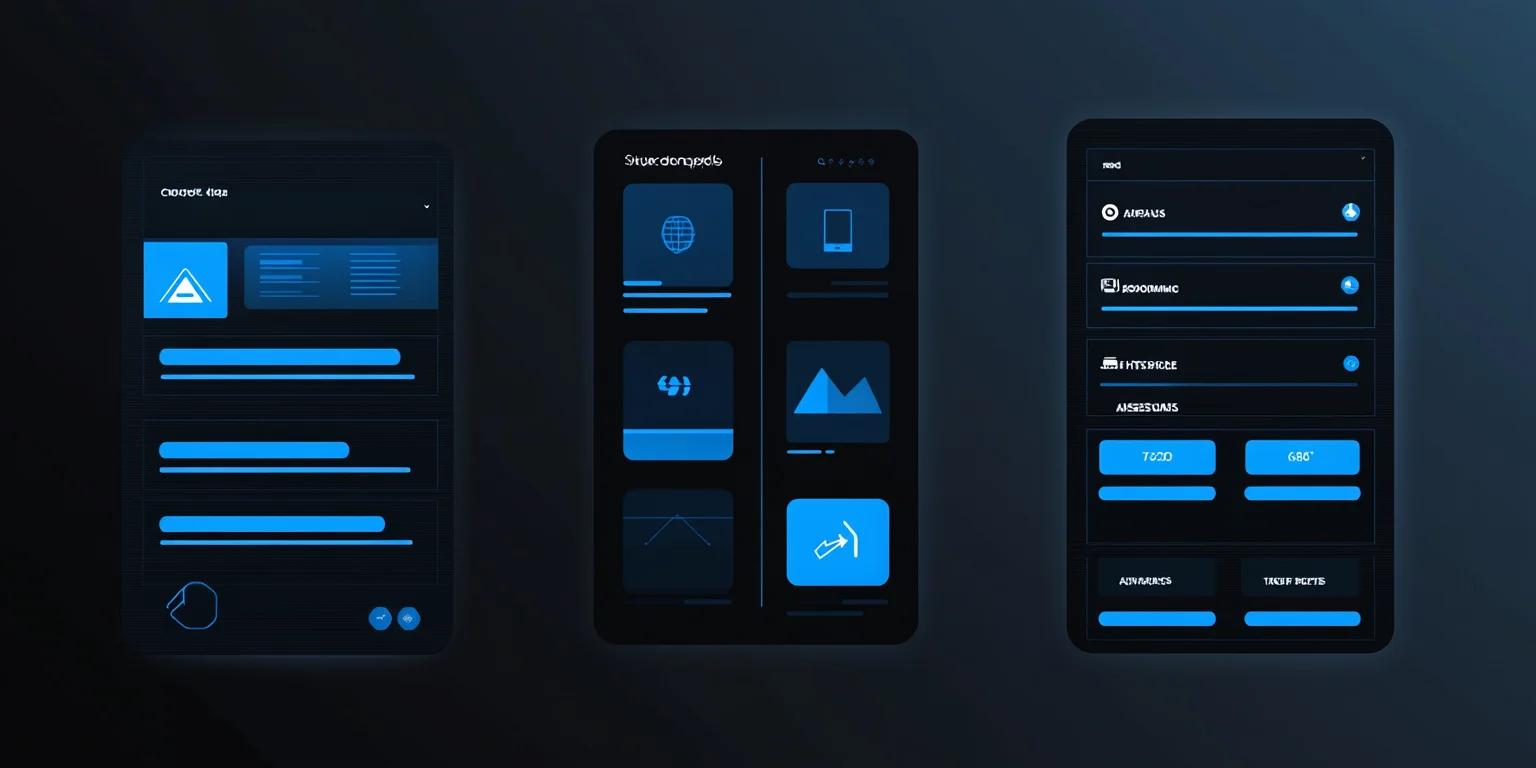Every dollar invested in UX design yields a return of $100, equating to an impressive ROI of 9,900%.
Investing into UX design is not just a smart business move - it is also one that builds trust with users by creating digital spaces that enhance usability and customer care.
In brief:
- Mobile menus simplify user interactions, making it easier to find key features on smaller screens.
- Designs like hamburger menus or bottom navigation bars cater to modern user behaviors and preferences.
- A well-designed menu improves accessibility so all users can interact with content effortlessly.
- Thoughtful layouts and easy-to-use menus contribute directly to user satisfaction and loyalty.

Introduction to 2025 UX Design Trends
With rapid advancements in technology, knowing the key UX design trends for 2025 will help you craft experiences that connect with users.
UX design influences how users interact with digital products, focusing on usability, efficiency, and enjoyment. A well-designed user experience can greatly enhance satisfaction and loyalty. Since over 92% of internet users access the web via mobile devices, responsive and accessible design is essential. Implementing effective mobile menu design can significantly improve navigation on mobile devices, enhancing the overall user experience.
How Trends Shape User Experience
Design trends reflect changes in technology and user behavior, guiding designers to improve the user experience. The integration of Artificial Intelligence (AI) is changing UX by enabling personalization and automating tasks. Tools like UXPin's Merge technology allow designers to focus on complex problems, improving the products users use.
Voice interfaces and augmented reality are changing how users engage with technology. Nearly half the US population is expected to use voice-activated technology by 2026, highlighting the need for intuitive voice interfaces. By embracing these trends, designers can meet users' evolving expectations. Implementing targeted UX design strategies for SaaS can further enhance user engagement and satisfaction.
Predicting the Future of UX
Looking ahead, UX design will emphasize personalization, accessibility, and ethical considerations. Emotionally intelligent design aims to understand and anticipate users' emotions, creating more empathetic products. Designers are becoming more business-savvy, aligning their work with measurable results.
Emerging technologies like AI, AR, and VR will play significant roles. As these technologies become part of daily life, designers must adapt to new interfaces and their impact on the user experience. In sectors such as healthcare, following MedTech UX design best practices is crucial when incorporating AI to meet users' needs and adhere to industry regulations. Focusing on deeper, complex problems will be key to delivering products that meet users' needs and enhance their interactions.
Without further ado, let's look into eight pivotal trends in UX design.
1. Immersive Experiences with AR and VR
In 2025, immersive technologies like Augmented Reality (AR) and Virtual Reality (VR) are changing how users interact with digital content, creating more engaging and personalized experiences.
AR is becoming integral to user experience design. With mobile AR users reaching 1.73 billion in 2024, designers are integrating AR to blend digital elements into the physical environment. In e-commerce, AR allows users to preview products in their own space, improving decision-making and bridging the gap between online and offline experiences.
VR is expanding from gaming into education, healthcare, and remote collaboration. Virtual environments enable immersive training, therapy sessions, and virtual offices where users can interact with others in real time. As VR technology becomes more accessible, designers are creating intuitive environments that enhance users' personal and professional lives.
Design Challenges and Opportunities
Designing for AR and VR presents unique challenges. Moving from 2D screens to 3D spaces requires rethinking user interactions and interfaces. Designers must consider spatial navigation, user comfort, and prevent motion sickness. Accessibility and inclusivity are crucial, ensuring that immersive experiences are usable by people of all abilities. Safety considerations in virtual environments are also important. Despite these challenges, AR and VR offer opportunities to innovate and redefine how users engage with digital content.
2. AI-Driven Personalization
Artificial Intelligence (AI) is reshaping how designers create personalized experiences for users.
AI technologies enable designers to tailor user experiences more precisely than ever before. By analyzing user behavior, preferences, and context, AI can adapt interfaces and content to meet individual needs. For example, AI can:
- Recommend products based on past purchases and browsing history
- Adjust interface layouts to suit individual user habits
- Provide personalized content feeds that match user interests
Over 80% of businesses have adopted AI in some form, using it to enhance personalization in their products. Incorporating technologies like AI and headless CMS integration can streamline content delivery and further personalize user experiences.
Industries like FinTech are particularly leveraging AI for personalization; understanding Fintech UX design principles can provide valuable insights into creating secure and user-friendly financial applications.
Ethical Considerations in AI Personalization
With greater personalization comes the responsibility to handle user data ethically. Designers must address concerns around privacy, transparency, and potential biases in AI systems. Key ethical considerations include:
- Ensuring user consent when collecting and using personal data
- Being transparent about how AI algorithms make decisions
- Mitigating biases in AI that could lead to unfair or discriminatory outcomes
Emphasizing ethical, inclusive, and transparent design practices is essential to build trust with users.
Balancing Automation with Human Touch
While AI enhances personalization through automation, maintaining a human element remains crucial. Emotional design and empathy are still key factors in creating meaningful user experiences. AI should assist, not replace, the human touch that connects with users on an emotional level. Designers need to:
- Incorporate empathy into AI-driven experiences
- Ensure that automated interactions feel natural and engaging
- Balance efficiency with personal connection to avoid making users feel like they're interacting with a machine
By combining AI capabilities with human-centered design, designers can create personalized experiences that resonate with users.
3. Voice and Conversational Interfaces
As voice-activated technology becomes more common, designing user experiences that incorporate voice and conversational interfaces is increasingly important.
With the rise of smart speakers and voice assistants like Alexa, Siri, and Google Assistant, Voice User Interfaces (VUIs) have evolved rapidly. By 2026, nearly half of the US population is expected to use voice assistants, underscoring the importance of voice technology. Incorporating VUIs into designs makes interactions more efficient and intuitive, offering hands-free convenience and improved accessibility.
Designing for Natural Language Processing
Designing for Natural Language Processing (NLP) means creating interfaces that understand and respond naturally to human speech. Designers must consider how users phrase queries and commands. Anticipating varied inputs and ensuring the system handles different languages, accents, and speech patterns are important. Effective NLP design enhances user satisfaction by providing accurate, context-aware responses.
Challenges in Creating Conversational UX
Conversational UX presents unique challenges. Maintaining seamless dialogue between user and system is a major hurdle. Designing natural conversations while avoiding misunderstandings is essential. Privacy and security concerns with voice data also arise. It's crucial to make users feel comfortable and trust the system with their voice interactions. Designers must consider current technology limitations and find ways to work within these constraints while delivering engaging experiences.
4. Minimalist and Micro Interactions
Embracing minimalist design and incorporating micro-interactions can significantly enhance your users' experience.
Minimalist design focuses on clean interfaces with essential elements, removing clutter to improve usability. Clean, minimalist designs remain popular, but designers are adding unique visual elements to make interfaces stand out without compromising usability. By adopting minimalism, you can create interfaces that are both aesthetically pleasing and functionally efficient. Staying informed about the latest trends in SaaS website design can help guide your minimalist approach and ensure your designs remain competitive.
Utilizing methodologies like the Atomic Design methodology can help break down interfaces into reusable components, enhancing consistency and efficiency in design.
Creating Impact with Micro Interactions
Micro-interactions are subtle animations and visual feedback that enhance user engagement. These micro-interactions make interfaces more engaging and provide users with immediate feedback on their actions. By integrating micro-interactions, you can guide users through tasks and make your interfaces feel more responsive and intuitive.
Case Studies of Successful Minimalist Designs
Several websites have effectively utilized minimalism to capture user attention. Examples like Awwwards' homepage and Lacoste's campaign site use typography as a key design element. By employing big, bold text and mixing typefaces, these sites reinforce brand messaging while maintaining a clean, minimalist aesthetic.
5. Sustainable and Ethical Design
As we look toward 2025, sustainable and ethical design has become a crucial focus in UX. Incorporating these principles benefits the environment and society and builds user trust and loyalty.
Sustainability in UX design involves creating digital products that minimize environmental impact. This can include optimizing websites and apps to reduce energy consumption, which is particularly important given the increasing number of users worldwide. Focusing on eco-friendly design solutions and optimizing energy use in digital products are key trends for 2025.
By designing with sustainability in mind, you contribute to a healthier planet while meeting the growing consumer demand for environmentally responsible products. Users are becoming more conscious of their digital carbon footprint and prefer services that align with these green values.
How to Design with Ethics in Mind
Ethical considerations are at the forefront of UX design. With the rise of AI and data-driven personalization, designers face new challenges around privacy, transparency, and inclusivity. The need to address issues like AI bias and manipulative design practices is highlighted.
When designing, it's essential to prioritize users' well-being and respect their data rights. This means being transparent about data usage, avoiding deceptive practices that trick users, and ensuring that products are accessible to everyone, including those with disabilities.
Tools and Resources for Ethical Design
To help incorporate ethical principles into your work, several tools and resources are available:
- Ethical Design Guide: A comprehensive resource that provides guidelines and best practices for ethical design decisions.
- Contrast Checker: Tools like the WebAIM Contrast Checker ensure that your designs meet accessibility standards for users with visual impairments.
- Privacy by Design Frameworks: Incorporate privacy considerations from the outset by following established frameworks that prioritize user data protection.
By leveraging these resources, you can create designs that are not only effective but also ethical and sustainable, contributing positively to users and society as a whole.
6. Accessibility and Inclusive Design
Designing for a diverse range of users, including those with disabilities, is increasingly crucial in UX design.
Focusing on accessibility ensures that everyone can interact with digital products effectively, regardless of their abilities. There's a growing emphasis on creating interfaces that are accessible to all users, which not only broadens your audience but also enhances user satisfaction.
Techniques to Enhance Accessibility
UX designers are encouraged to incorporate web accessibility best practices into their designs. Some effective techniques include:
- Alt Text for Images: Providing descriptive text for images enables screen readers to convey information to visually impaired users.
- Closed Captions for Videos: Adding captions to videos ensures that users who are deaf or hard of hearing can understand the content.
- Screen-Reading Options: Implementing features that support screen readers helps users navigate and interact with content more effectively.
By integrating these practices, you can create more inclusive products that cater to the needs of all users.
7. Biometric Authentication and Security
As technology advances, security measures like biometric authentication are becoming more common in UX design. While these innovations enhance user experience, they also bring privacy concerns that you need to address.
With the rise of AI and data-driven personalization, privacy has become a significant concern in UX design. Challenges around AI bias, transparency, and manipulative design practices are pushing designers to prioritize ethical considerations. Focusing on ethical, inclusive, and transparent design is essential to respect user privacy.
You need to be mindful of how digital products impact users' well-being. Addressing privacy concerns isn't just about compliance but about building trust with your users. By ensuring that users understand how their data is collected and used, and by being transparent in design practices, you can enhance user trust and engagement.
Building and maintaining user trust is increasingly challenging in the digital age. As a designer, considering the societal impact of your work is crucial. Proactively addressing privacy concerns helps create experiences where users feel safe and respected.
8. Cross-Platform and Multi-Device Experiences
In today's digital world, users interact with products across a variety of devices—smartphones, tablets, desktops, and even smart TVs. Ensuring a seamless experience on all these platforms is essential for keeping users engaged and satisfied.
Designing for multiple devices is no longer optional. Users expect to start a task on one device and continue it on another without any friction. This means your design must be responsive and intuitive across all platforms.
How to Design for Cross-Platform Consistency
Creating a consistent experience doesn't just mean shrinking or expanding your interface to fit different screens. It's about optimizing the user experience for each device while maintaining a cohesive look and feel. For instance:
- Platform-Specific Optimization: Instagram enhanced its desktop version to include features that were once mobile-only, recognizing the need to cater to users on different devices.
- Adapted Content Formats: YouTube introduced stories similar to TikTok's format to engage users who prefer that style of content consumption.
When designing, consider:
- User Interaction Patterns: Touch gestures on mobile vs. click-and-scroll on desktop.
- Visual Consistency: Use consistent color schemes, typography, and icons to reinforce your brand identity.
- Feature Prioritization: Highlight the most relevant features on each platform based on how users interact with it.
As modern web development evolves, understanding the future of composable websites can help designers create flexible, scalable experiences that adapt to various platforms.
When working with modern web architectures, familiarizing yourself with key composable web development terms can be beneficial for understanding how to create seamless, scalable experiences.
Tools for Multi-Device Prototyping
Leveraging the right tools can streamline the process of designing and testing across devices. Advanced prototyping tools like UXPin allow you to:
- Create Interactive Prototypes: Build prototypes that mimic the final product's behavior on different devices.
- Test Device-Specific Interactions: Simulate how your design responds to touch, swipe, or mouse clicks.
- Collaborate and Gather Feedback: Share prototypes with team members and stakeholders to collect input early in the design process.
By using these tools, you can identify and fix usability issues before they become costly problems, ensuring your design offers a seamless experience no matter how users access it.
Bonus Trend: Sustainable UX Design Practices
Sustainability in design focuses on creating experiences that minimize environmental impact while encouraging mindful behaviors among users.
UX designers have the power to influence both digital efficiency and user habits. Energy-efficient design is one example—prioritizing lightweight websites and apps reduces server loads, energy consumption, and carbon emissions. Designers can achieve this by using optimized code, compressing images, and streamlining interactions to limit resource-heavy processes.
Sustainable UX extends beyond technology. It involves prompting users to make choices that align with eco-conscious practices. For instance, interfaces can subtly highlight sustainable options in e-commerce or promote energy-saving settings in digital products. These prompts can guide user behavior without being intrusive.
Another dimension is accessibility and inclusivity. Building products that are universally usable not only enhances user satisfaction but also reduces the need for redundant systems. Designers should aim for longevity, focusing on adaptable solutions that work across devices and platforms, decreasing the frequency of redesigns and upgrades.

Our Take on The Top 8 UX Design Trends to Watch for in 2025
The UX landscape continues to prioritize user-centric approaches, but the focus is shifting toward meaningful innovation. Emerging trends emphasize personalization, inclusivity, and intuitive interfaces as the backbone of UX designs. What stands out is the balance between innovation and simplicity - users expect engaging, high-tech experiences that remain easy to use.
Also, trends like AI integration and sustainable design practices reflect broader societal and technological shifts. The challenge for designers lies in blending forward-thinking ideas with practical implementation to make sure designs resonate with users without overcomplicating their experience.
Conclusion and Future Outlook
In 2025, UX design is influenced by several key trends. Artificial intelligence automates tasks and enables personalized experiences. Designers are shifting toward strategic roles, emphasizing UX research and complex problem-solving. Ethical considerations are becoming crucial, in addressing issues like privacy and user trust. Emerging technologies such as augmented reality, virtual reality, and mixed reality are expanding how users interact with products. Cross-platform consistency and emotionally intelligent design also shape user experiences.
To navigate these changes, you should embrace continuous learning and adapt to new technologies. Developing skills in AI integration, designing for new interfaces, and understanding ethical implications are essential. Focusing on strategic thinking and aligning design with business goals will enhance your impact in the field.
Here at Webstacks, we help many companies level up their online presence through next-gen solutions for websites.
If you want to learn more about this or any other topic, feel free to reach out to us!





